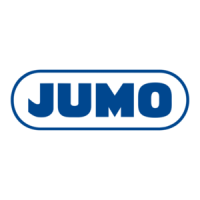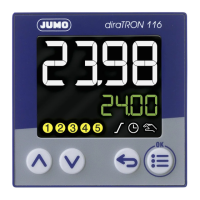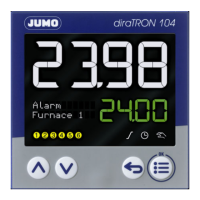70357100T10Z002K000
Description
Controller types
The controller can be configured as a two-
state controller, three-state controller, modu-
lating controller, continuous controller, or con-
tinuous controller with integrated position
controller. The cycle time is 150 ms.
Parameter blocks
Four parameter blocks can be assigned to
each controller. Each parameter block has 15
parameters. The controller structures P, I, PD,
PI, and PID can be adjusted.
Self-optimization
Self-optimization also makes it possible for the
controller to be matched to the control path by
a user who is not a control technology expert.
The way the control path reacts to changes in
the actuating variable is evaluated in the pro-
cess. Two different optimization processes are
available. The oscillation method is preset as
the standard method in the controller.
User level
Up to 25 parameters of any type from the con-
figuration or parameter level can be included
in this level. These parameters, for example,
often need to be changed or made available to
operating personnel (see "User administra-
tion").
User administration
Password-protected user administration guar-
antees safe process operation. This function
allows the individual assignment of rights, en-
abling four users to access different levels and
control commands.
Setpoint values
Up to four setpoint values can be entered for
each controller channel. Toggling these set-
point values is controlled by two binary-coded
digital signals. However, the setpoint values
for both controllers can also be specified as an
external setpoint specification via an addition-
al analog input or an interface.
Program controller (extra code)
Ten programs with 50 sections can be pro-
grammed in the program controller. Each pro-
gram can be assigned a program name and
an icon.
Two setpoint values, section run times, operat-
ing contacts, tolerance bands, cycles, and pa-
rameter blocks can be assigned in each
program section.
The tolerance band monitoring function moni-
tors the actual value in an adjustable band
around the setpoint value. The output signal of
the tolerance band monitoring function can, for
example, also be used to stop the program.
Ramp function
The ramp function allows a continuous change
of the setpoint value to the ramp end value
(setpoint specification) for each controller
channel. After power ON, the ramp starts at
the current actual value. The slope of the ramp
is determined via different gradients for a ris-
ing and falling ramp. The ramp starts at the
time the setpoint value is changed or at the
same time as a digital signal. The ramp func-
tion can be controlled by digital signals or via
the functional level.
Limit value monitoring
There are 16 limit value monitorings each with
8 selectable alarm functions AF1 to AF8 avail-
able. The limit value can be fixed or be depen-
dant on another value (setpoint value).
Using additional parameters such as location
and value of the switching differential, switch
on/off delay, pulse function, type of acknowl-
edgement and start-up alarm suppression ex-
tensive functions may be realized. Processes
can be hindered through the start-up alarm
suppression, for example the activation of the
limit value monitoring during the start-up
phase.
Math and logic function (extra
code)
The math and logic module allows analog and/
or digital signals to be operated. The following
math formulas are available to the operators:
+, -, *, /, SQRT(), MIN(), MAX(), SIN(), COS(),
TAN(), **, EXP(), ABS(), INT(), FRC(), LOG(),
LN(), humidity and floating average, as well as
!, &, |, ^, and ( and ).
Difference, ratio, and humidity can also be
configured on the device without extra code.
Analog inputs
The analog inputs (maximum of four) are uni-
versally configurable for RTD temperature
probes, thermocouples, resistors (resistance
transmitters, potentiometers), and standard
signals (current, voltage). Linearizations for
over 20 common measuring probes are
saved. A measured value offset or a fine ad-
justment can be carried out to compensate for
machine-specific deviations.
Due to the measuring circuit monitoring, out of
range measurements (too high or too low),
probe/cable break, and probe/cable short cir-
cuit are detected depending on the type of
measuring probe. Due to the measuring circuit
monitoring function, out of range (too high or
too low), probe/cable break, and probe/cable
short circuit are detected depending on the
type of measuring probe so that the system is
switched to a safe operating status (configu-
rable) in the event of a fault.
Customer-specific
linearization
A customer-specific linearization is additional-
ly possible. Programming is carried out with
the aid of the setup program, using a value ta-
ble with 40 pairs of values or a fourth-order
polynomial as a formula.
Analog outputs
Up to five analog outputs can be realized in the
device. They can be used, for example, as
controller outputs, setpoint value outputs, to
output results of the math formulas, or as ac-
tual value outputs. The signals are freely scal-
able.
Digital inputs
The signals of the seven standard digital in-
puts (potential-free contacts) can be used to
initiate different internal functions, for example
switching the parameter block, starting self-
optimization, or acknowledging limit value
monitoring.
Digital outputs
Up to 12 digital outputs can be realized in the
device (see block diagram). They can be used
as, for example, controller outputs, limit value
monitoring signals, results of logic operations,
or for programmer signals, etc.
External inputs
Eight external analog inputs and eight external
digital inputs can each by read via an inter-
face. The unit, range limits, and alarms can be
adjusted for the external analog inputs.
Timers
Two timer functions are provided as standard.
They can be used as relative timers or as
weekly time switches (linked to the real-time
clock).
Digital controller signals
There are eight digital control signals with dif-
ferent functions (OR operation, BCD opera-
tion, delay, inversion). The results are also
available to control internal functions or they
can be output to digital outputs.
Web server (online visualization)
This function is available with the insertion of
the Ethernet interface on expansion slot
COM2. All appearances in the device operat-
ing loop are automatically attainable without
configuration.
Alarm transmission by email
An email alarm can be sent to up to three ad-
dresses simultaneously via a mail server.
Up to five alarm messages can be configured;
the sending process is controlled by digital sig-
nals. There are five different alarm messages
for this. These are linked to specific digital sig-
nals from the device.
